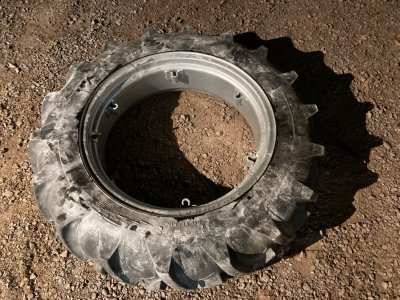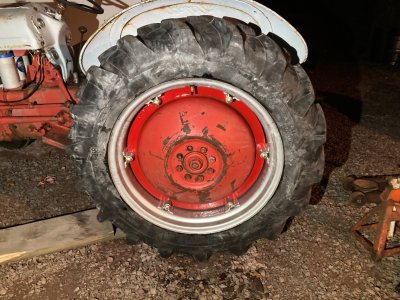The tire is good enough, I’m going to reuse it.If both rim and tire are shot, then it's plainly simple. Remove it and slap on a better one in it's place.
Then offer the broken one on Craigs List in the FREE section. You will never need to dispose of it.
You are using an out of date browser. It may not display this or other websites correctly.
You should upgrade or use an alternative browser.
You should upgrade or use an alternative browser.
I acquired a Ford 8n
- Thread starter IHCubCadet147
- Start date
Thats how my Yanmar wheel looked.I noticed some rot around the valve stem on the other side too. Hopefully it’s not much worse inside and can be fixed. I have to take care of that soon before it gets worse.
Hate to say it Nick but that one don't look to good either..I got the tire off yesterday. Here’s a few more pictures.
View attachment 87596View attachment 87597View attachment 87598View attachment 87599
I noticed some rot around the valve stem on the other side too. Hopefully it’s not much worse inside and can be fixed. I have to take care of that soon before it gets worse.
View attachment 87600
Take a chipping hammer to it and it will tell you more..
No it doesn’t, but as long as the rest of it is solid, I can probably patch it. The rest of that rim looks good, although I don’t know what it looks like on the inside.Hate to say it Nick but that one don't look to good either..
Take a chipping hammer to it and it will tell you more..
You got to HATE how tire filling with calcium chloride over the years literally destroyed the rims.I got the tire off yesterday. Here’s a few more pictures.
View attachment 87596View attachment 87597View attachment 87598View attachment 87599
I noticed some rot around the valve stem on the other side too. Hopefully it’s not much worse inside and can be fixed. I have to take care of that soon before it gets worse.
View attachment 87600
Pink RV antifreeze is all I ever use for tire ballast. When on sale, it's $1 per gallon in the early Spring. Yet after 2020, I've not seen a deal like that in a long time.
If I fill these again, I will either use windshield washer fluid or antifreeze. Probably whichever is cheaper. I think I’m going to try it with just air first then decide if they need to be filled or not.You got to HATE how tire filling with calcium chloride over the years literally destroyed the rims.
Pink RV antifreeze is all I ever use for tire ballast. When on sale, it's $1 per gallon in the early Spring. Yet after 2020, I've not seen a deal like that in a long time.
Kinda agree with you Nick on refilling the tires. Makes no sense if you're not planning on doing hard work or pulling with it.If I fill these again, I will either use windshield washer fluid or antifreeze. Probably whichever is cheaper. I think I’m going to try it with just air first then decide if they need to be filled or not.
Today's washer fluids are now a regulated formula by the EPA, it's mostly ethanol. In time, it will corrode just like the calcium chloride.If I fill these again, I will either use windshield washer fluid or antifreeze. Probably whichever is cheaper. I think I’m going to try it with just air first then decide if they need to be filled or not.
There are 2 antifreeze formula's. the unsafe for pets and farm animals and the pet safe. The pink RV/Marine is the safe stuff. Propylene glycol will not cause rust, it is very slippery, and we eat it on our BBQ ribs, in salad dressings, in soft ice cream and gummy bears. Yes, for real. It is an FDA approved sweetener and it's also in many diabetic labeled foods too. (and don't get me going about the FAKE black olives either).
The ethylene glycol formulas will eat thru today's inner tubes. And the stupid so called Long Life antifreeze (OAT or HOAT) has only 33% corrosion protection compared to the old school green stuff with 99% protection. Thus, the inside of the rims will rust sooner.
Now, there are full formulas for radiator pet safe as well, but you are correct in stating, 'which is cheaper'. Thus, it's either the Beet Juice or the pink safe stuff.
Cost wise, mounted wheel weights are the way to go. The 2N, 8N, 9N, and the other later models use these.
And even today, some of the Caterpillar machines use this too. You would only need 6-halves. They fit on the INSIDE of the rim, unseen really.

Over the years, I've seen these painted red, white or black.

Last edited:
Thanks for the info. I did not know that washer fluid was corrosive. Looks like antifreeze is the way to go.Today's washer fluids are now a regulated formula by the EPA, it's mostly ethanol. In time, it will corrode just like the calcium chloride.
There are 2 antifreeze formula's. the unsafe for pets and farm animals and the pet safe. The pink RV/Marine is the safe stuff. Propylene glycol will not cause rust, it is very slippery, and we eat it on our BBQ ribs, in salad dressings, in soft ice cream and gummy bears. Yes, for real. It is an FDA approved sweetener and it's also in many diabetic labeled foods too. (and don't get me going about the FAKE black olives either).
The ethylene glycol formulas will eat thru today's inner tubes. And the stupid so called Long Life antifreeze (OAT or HOAT) has only 33% corrosion protection compared to the old school green stuff with 99% protection. Thus, the inside of the rims will rust sooner.
Now, there are full formulas for radiator pet safe as well, but you are correct in stating, 'which is cheaper'. Thus, it's either the Beet Juice or the pink safe stuff.
Cost wise, mounted wheel weights are the way to go. The 2N, 8N, 9N, and the other later models use these.
And even today, some of the Caterpillar machines use this too. You would only need 6-halves. They fit on the INSIDE of the rim, unseen really.
View attachment 87631
Over the years, I've seen these painted red, white or black.
View attachment 87632
No, windshield washer fluid is not corrosive to metals. However, undiluted windshield washer fluid can damage a vehicle's paint or rubber seals over time. The solvent in windshield washer fluid can also damage a vehicle's clear coat. To protect against this, you can use a sealant.
LOL..Wheels look good! You shouldn't have to deal with them again in your lifetime.
The guy that bought that 8n new back in the day probably thought the same thing when he put calcium in...
Turned out to be Nicks problem..
Last edited:
Let's take the top two washer fluids, Splash sold at Walmart and elsewhere ... and Homestar who makes many of the other brands like Prestone with a little EG added.No, windshield washer fluid is not corrosive to metals. However, undiluted windshield washer fluid can damage a vehicle's paint or rubber seals over time. The solvent in windshield washer fluid can also damage a vehicle's clear coat. To protect against this, you can use a sealant.
Splash SDS
Homestar SDS
Both are Methanol based.
Methanol-Induced Corrosion
Last updated: July 19, 2024
Methanol-Induced Corrosion
What Does Methanol-Induced Corrosion Mean?
Methanol-induced corrosion is a type of corrosion induced by methanol. It is a recognized problem in the gas and oil industries, pipelines, municipal sewage treatment systems, and a variety of industrial applications. Stress-corrosion cracking has been observed in absolute methanol.
For solutions with a methanol content of 50% or more, the corrosion rate of carbon steel is significantly higher in the aerobic environment than the anaerobic environment.
The effect of methanol on corrosion is more complicated in acidic environments; the risk of localized corrosion increases with methanol content even though the general corrosion rate appears unaffected. An associated risk with the use of methanol is that oxygen is more soluble in methanol than in water.
Pitting corrosion was observed when the methanol content was 50% or more. When present in large quantities, methanol may compete with H2S for adsorption sites on the metal surface and block the passage of H2S, resulting in the formation of an uneven iron sulfide film. A metal surface with an inconsistent protective film is more prone to localized corrosion.
Under acidic gas conditions, the presence of methanol can increase the risk of sulfide stress cracking (SSC) and stress-oriented hydrogen induced cracking. Methanol can increase the rate of vapor phase corrosion, which directly increases the risk of a top-of-the-line corrosion failure.
---
Normally tractor tires are filled 2/3rds up or right at the high side part of the rim as shown.
This allows left over air in the tire. Methanol reacts with this air to steel as stated above.

I would only use beet juice or the RV/Marine pink stuff for a liquid fill.

The tube started leaking in the other rear tire, so I ordered another new rim and tube and got them changed over the weekend. This rim was rotted around the valve stem, but the rest of it was still solid. I was expecting the inside to look much worse. I probably could have fixed it, but I decided to just get a new one.

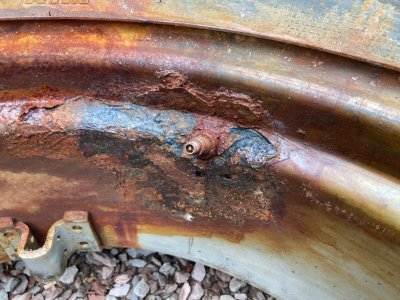
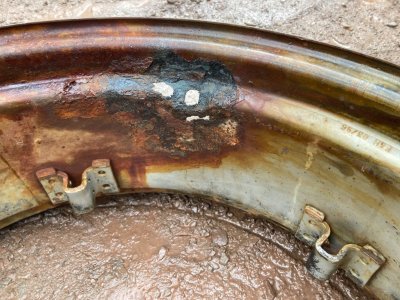



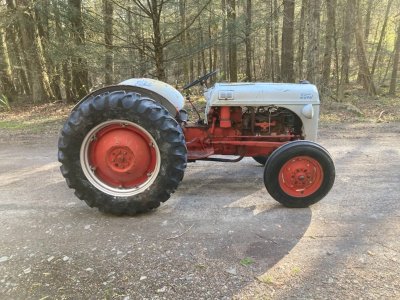









Your set for the rest of your life now. Just park with the tires out of the sun and they will last many years.This rim was rotted around the valve stem, but the rest of it was still solid. I was expecting the inside to look much worse. I probably could have fixed it, but I decided to just get a new one.
The price off tires has gone through the roof. When I purchased my Ford 850 It needed 2 rims and two tires. At the time (late 90's) it cost $800 to get it done through the plants account. Ten years later after purchasing the Fordson I needed 1 rear tire. I think it was around $900 for that one tire on my own. With the tariffs I'd hate to think what it's going to cost to put tires on the car this fall. Maybe cheaper to get a new car?
Unfortunately, the two rear tires don’t match, and one is a little bigger than the other, so I would like to either find another tire to match one of them, or a matching set. I definitely won’t be buying new tires though. I didn’t spend too much time looking, but it looks like tires this size start around $300 each. I’m going to need a set of tires on my truck very soon, I’m not looking forward to that.Your set for the rest of your life now. Just park with the tires out of the sun and they will last many years.
The price off tires has gone through the roof. When I purchased my Ford 850 It needed 2 rims and two tires. At the time (late 90's) it cost $800 to get it done through the plants account. Ten years later after purchasing the Fordson I needed 1 rear tire. I think it was around $900 for that one tire on my own. With the tariffs I'd hate to think what it's going to cost to put tires on the car this fall. Maybe cheaper to get a new car?
That’s why I decided to go with a new one. If I had patched it, I probably would have had problems with it again at some point.Pretty tricky to repair that wheel, Nick, but that new one will last a lifetime now. You can trust that there won't be a blowout around that area while you are out working the tractor!
DAC







